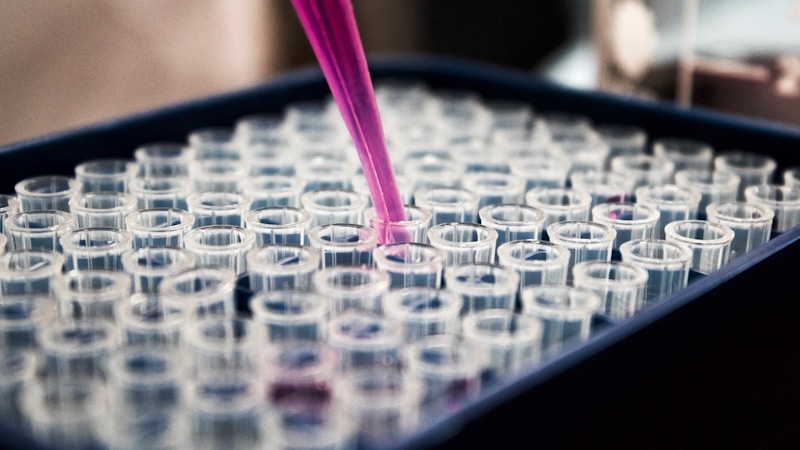
The landscape of modern medicine is experiencing a transformation that would have seemed like science fiction just two decades ago. CRISPR gene editing technology, a revolutionary tool that allows scientists to precisely modify DNA sequences, has emerged as one of the most promising innovations in healthcare and life sciences. This groundbreaking approach is not merely advancing our understanding of genetics—it's fundamentally changing how we treat diseases, develop pharmaceuticals, and envision the future of human health.
Since its development as a practical gene-editing tool in 2012, CRISPR (Clustered Regularly Interspaced Short Palindromic Repeats) has rapidly evolved from a laboratory curiosity to a therapeutic reality. With the first CRISPR-based treatments now approved for clinical use and hundreds of trials underway worldwide, we're witnessing the dawn of a new era in precision medicine where previously incurable genetic disorders may become manageable or even curable conditions.
Understanding CRISPR Technology: The Molecular Scissors
At its core, CRISPR functions like molecular scissors, allowing scientists to cut DNA at precise locations and either remove problematic sequences, insert new genetic material, or repair mutations that cause disease. The system consists of two main components: a guide RNA that directs the machinery to the correct location in the genome, and the Cas9 protein that acts as the cutting enzyme. This elegant simplicity has made CRISPR far more accessible, affordable, and efficient than previous gene-editing technologies.
According to research on CRISPR gene editing, what makes this technology particularly revolutionary is its precision and versatility. Unlike earlier genetic engineering methods that were time-consuming, expensive, and often imprecise, CRISPR can target specific genes with remarkable accuracy. Scientists can now edit multiple genes simultaneously, create disease models for research, and develop targeted therapies in timeframes that were previously impossible.
The mechanism behind CRISPR is actually borrowed from bacteria, which use this system as a primitive immune defense against viruses. When scientists discovered they could repurpose this bacterial defense system for precise genetic modifications in any organism, it opened extraordinary possibilities across medicine, agriculture, and biological research. The simplicity and effectiveness of CRISPR have democratized genetic research, allowing laboratories worldwide to pursue innovations that were once limited to well-funded institutions with specialized expertise.
Medical Breakthroughs: From Laboratory to Patient Care
The transition of CRISPR from experimental technology to approved medical treatment represents a historic milestone in healthcare innovation. In late 2023, regulatory authorities approved the first CRISPR-based therapy for sickle cell disease and beta-thalassemia, marking the beginning of a new therapeutic era. These blood disorders, which have caused immense suffering for millions of patients worldwide, can now potentially be cured through a single treatment that corrects the underlying genetic cause.
The treatment process for these approved therapies involves extracting patients' stem cells, editing them using CRISPR to correct or compensate for the genetic mutations causing disease, and then reinfusing the corrected cells back into the patient. Early results have been remarkable, with patients experiencing complete resolution of symptoms that previously required lifelong management with blood transfusions and medications. This success has validated the CRISPR approach and energized research into treatments for other genetic conditions.
Beyond blood disorders, CRISPR research is advancing rapidly across numerous disease areas:
- Cancer immunotherapy: Engineering immune cells to better recognize and attack tumors
- Inherited blindness: Correcting genetic mutations that cause retinal degeneration
- Muscular dystrophy: Repairing mutations in genes responsible for muscle function
- Cardiovascular disease: Modifying genes that control cholesterol levels and heart function
- HIV treatment: Editing cells to resist infection or eliminate viral reservoirs
- Rare genetic disorders: Addressing diseases caused by single gene mutations
Clinical trials are currently underway for many of these applications, with results suggesting that CRISPR-based therapies could transform previously untreatable conditions into manageable or curable diseases. The pharmaceutical industry has invested billions of dollars into developing CRISPR therapeutics, recognizing this technology's potential to address unmet medical needs and create entirely new treatment paradigms.
Pharmaceutical Innovation and Drug Development
Beyond direct therapeutic applications, CRISPR is revolutionizing how pharmaceutical companies discover and develop new drugs. Traditional drug development often relies on trial and error, testing thousands of compounds to find ones that affect disease pathways. CRISPR enables a more targeted approach by allowing researchers to systematically identify which genes are involved in disease processes and how modifying them affects outcomes.
Pharmaceutical researchers now use CRISPR to create precise disease models in cells and animals, helping them understand disease mechanisms at a molecular level. This accelerates the identification of drug targets—the specific proteins or pathways that medications should interact with to produce therapeutic benefits. By clarifying which genetic changes cause or contribute to disease, CRISPR helps researchers focus drug development efforts on the most promising targets, potentially reducing the time and cost required to bring new medicines to market.
CRISPR technology is also being used to optimize drug manufacturing processes. Researchers can edit cells used in biopharmaceutical production to increase yield, improve product quality, and reduce manufacturing costs. This application may help make expensive biological drugs more affordable and accessible to patients who need them, addressing a major healthcare challenge in both developed and developing countries.
Challenges and Ethical Considerations
Despite its tremendous promise, CRISPR technology faces significant challenges that researchers and society must address responsibly. The most pressing concern involves off-target effects—unintended genetic changes that occur when CRISPR cuts DNA at locations other than the intended target. While the technology has become increasingly precise, the possibility of unintended modifications raises safety concerns, particularly for germline editing that would affect future generations.
According to bioethics frameworks, the ability to edit human genes raises profound ethical questions about how far we should go in modifying ourselves and our descendants. While few dispute the value of correcting disease-causing mutations, debates intensify around potential applications like enhancing physical or cognitive traits, selecting characteristics in embryos, or making changes that would be inherited by future generations. These discussions involve considerations about equity, consent, unintended consequences, and the definition of disease versus normal variation.
The scientific community has generally embraced a cautious approach, with broad consensus that germline editing (modifications that can be inherited) should remain limited to preventing serious diseases until safety and ethical frameworks are more firmly established. However, international coordination remains challenging, as different countries have varying regulations and ethical standards regarding genetic modification. The possibility of "designer babies" or genetic enhancement raises concerns about exacerbating social inequalities and fundamentally altering human evolution.
Practical challenges also persist in making CRISPR therapies accessible and affordable. Current approved treatments cost hundreds of thousands or even millions of dollars per patient, placing them out of reach for most people globally. Developing delivery methods that can efficiently and safely deliver CRISPR machinery to the right cells in the body remains technically challenging for many applications. Researchers continue working to improve the technology's precision, efficiency, and safety while reducing costs to ensure these breakthrough treatments can benefit patients worldwide.
Future Prospects: What's Next for Gene Editing
The future of CRISPR technology extends far beyond current applications, with researchers developing enhanced versions that offer improved precision, new capabilities, and broader applications. Prime editing, base editing, and other advanced techniques allow even more precise modifications without cutting both strands of DNA, potentially reducing off-target effects and expanding the range of genetic changes that can be safely made.
Scientists are exploring CRISPR applications in infectious disease treatment, using the technology to target and destroy viral DNA or RNA. This approach could potentially treat chronic viral infections like herpes, hepatitis B, and HIV by eliminating viral genetic material from infected cells. CRISPR-based diagnostics are also emerging, offering rapid, affordable disease detection that could transform healthcare in resource-limited settings.
Looking further ahead, CRISPR may enable regenerative medicine approaches where damaged tissues and organs can be repaired or regenerated by correcting genetic problems in patients' own cells. Xenotransplantation—using organs from genetically modified animals for human transplantation—is being explored using CRISPR to modify pig organs to be compatible with human immune systems, potentially addressing the severe shortage of donor organs.
The convergence of CRISPR with other emerging technologies like artificial intelligence, synthetic biology, and advanced diagnostics promises to accelerate innovation even further. Machine learning algorithms are already being used to design more effective guide RNAs and predict off-target effects, while synthetic biology approaches combine CRISPR with other genetic tools to create complex cellular programs for therapeutic purposes.
Comparing Traditional Treatments to CRISPR-Based Therapies
Traditional treatments for genetic diseases typically manage symptoms rather than addressing underlying causes. Patients with sickle cell disease, for example, require lifelong blood transfusions, pain management, and treatments for complications. These approaches improve quality of life but don't cure the disease, and many patients still experience significant morbidity and reduced lifespan despite optimal care.
CRISPR-based therapies offer fundamentally different approaches by correcting or compensating for the genetic root cause of disease. Rather than managing symptoms indefinitely, these treatments potentially provide one-time cures that eliminate the need for ongoing interventions. Early results from approved CRISPR therapies show dramatic improvements, with patients who previously required monthly hospital visits for transfusions experiencing complete resolution of symptoms after a single treatment course.
However, current CRISPR therapies require complex procedures including cell extraction, laboratory editing, and cell reinfusion, making them expensive and accessible only at specialized centers. Traditional treatments, while less effective at addressing disease causes, are often more widely available and don't require the sophisticated infrastructure needed for gene therapy. As CRISPR technology matures and delivery methods improve, the goal is developing simpler approaches that can be administered more broadly while maintaining the curative potential that makes gene editing so revolutionary.
Conclusion: A New Chapter in Medical History
CRISPR gene editing represents more than just another medical technology—it's a paradigm shift in how we understand and treat disease. By providing precise tools to modify the genetic instructions that govern health and disease, CRISPR opens possibilities that were unimaginable just a generation ago. The approval of the first CRISPR therapies marks only the beginning of what will likely be a transformative era in medicine.
As research continues and the technology improves, we can expect CRISPR-based treatments to expand from rare genetic diseases to more common conditions affecting millions of people worldwide. The potential to cure rather than merely manage disease, combined with applications in drug development and medical research, positions CRISPR as one of the most significant medical innovations of the 21st century.
However, realizing this potential requires careful attention to safety, ethics, and accessibility. The medical and scientific communities must work together with policymakers, ethicists, and the public to ensure CRISPR technology is developed responsibly, deployed equitably, and governed by thoughtful frameworks that protect individual and collective interests. When managed wisely, CRISPR gene editing promises to alleviate suffering from diseases that have plagued humanity throughout history, offering hope to millions of patients and families affected by genetic disorders.
The revolution has begun, and its impact on healthcare, life sciences, and human wellbeing will likely be felt for generations to come. As we stand at this pivotal moment in medical history, the challenge is ensuring that the extraordinary promise of CRISPR technology translates into real benefits for patients worldwide, regardless of geography or economic status, while maintaining the ethical standards that must guide such powerful capabilities.
Follow Us: For more updates, stories, and partner links — visit our official
Facebook Page
and explore
Our Sister Sites.

CRISPR Gene Editing: Revolutionary Breakthroughs Transforming Modern Medicine






















.jpeg)


.jpeg)

.jpg)

.jpg)
.jpg)
.jpg)